E-Cadherin Is Important in the In Vitro Postnatal Development and Function of Pig Islets
Abstract
1. Introduction
2. Materials and Methods
2.1. Neonatal Pig Islet Isolation and Culture
2.2. Light Microscopy
2.3. Gene Expression Determined by Reverse Transcription Quantitative PCR (RT-qPCR)
2.4. Protein Expression Quantified by ProteinSimple’s Western Immunoassay
2.5. Immunostaining of Islets
2.6. In Vitro Islet Function Assessment by the Glucose-Stimulated Insulin Secretion Assay
2.7. Statistical Analysis
3. Results
3.1. Morphology and Viability of Islets from Various Ages of Neonatal Pigs
3.2. Significant Discrepancies in RNA Quality Using RIN Assessment and RNAIQ Assays
3.3. Variable Changes in the Gene and Protein Expression of E-Cadherin During In Vitro Postnatal Development
3.4. Variable Changes in the Gene Expression of RAC1 and Insulin During In Vitro Postnatal Development
3.5. Variable Changes in the Gene and Protein Expression of SNAP25 During In Vitro Postnatal Development
3.6. In Vitro Insulin Secretory Capacity of Islets Obtained from 1-, 3-, and 7-Day-Old Neonatal Pigs
3.7. Treatment of Islets with Anti E-Cadherin Monoclonal Antibody Resulted in Reduced In Vitro Insulin Secretory Capacity
4. Discussion
5. Conclusions
Supplementary Materials
Author Contributions
Funding
Institutional Review Board Statement
Data Availability Statement
Acknowledgments
Conflicts of Interest
References
- Cooper, D.K.C.; Ekser, B.; Tector, A.J. A Brief History of Clinical Xenotransplantation. Int. J. Surg. 2015, 23, 205–210. [Google Scholar] [CrossRef] [PubMed]
- Groth, C.; Korsgren, O.; Tibell, A. Transplantation of Porcine Fetal Pancreas to Diabetic Patients. Lancet 1994, 344, 1402–1404. [Google Scholar] [CrossRef] [PubMed]
- Hering, B.J.; Wijkstrom, M.; Graham, M.L.; Hårdstedt, M.; Aasheim, T.C.; Jie, T.; Ansite, J.D.; Nakano, M.; Cheng, J.; Li, W.; et al. Prolonged Diabetes Reversal after Intraportal Xenotransplantation of Wild-Type Porcine Islets in Immunosuppressed Nonhuman Primates. Nat. Med. 2006, 12, 301–303. [Google Scholar] [CrossRef] [PubMed]
- Cardona, K.; Korbutt, G.S.; Milas, Z.; Lyon, J.; Cano, J.; Jiang, W.; Bello-Laborn, H.; Hacquoil, B.; Strobert, E.; Gangappa, S.; et al. Long-Term Survival of Neonatal Porcine Islets in Nonhuman Primates by Targeting Costimulation Pathways. Nat. Med. 2006, 12, 304–306. [Google Scholar] [CrossRef]
- Coe, T.M.; Markmann, J.F.; Rickert, C.G. Current Status of Porcine Islet Xenotransplantation. Curr. Opin. Organ. Transplant. 2020, 25, 449–456. [Google Scholar] [CrossRef]
- Cabrera, O.; Berman, D.M.; Kenyon, N.S.; Ricordi, C.; Berggren, P.-O.; Caicedo, A. The Unique Cytoarchitecture of Human Pancreatic Islets Has Implications for Islet Cell Function. Proc. Natl. Acad. Sci. USA 2006, 103, 2334–2339. [Google Scholar] [CrossRef]
- Kim, A.; Miller, K.; Jo, J.; Kilimnik, G.; Wojcik, P.; Hara, M. Islet Architecture: A Comparative Study. Islets 2009, 1, 129–136. [Google Scholar] [CrossRef]
- Mueller, K.R.; Balamurugan, A.N.; Cline, G.W.; Pongratz, R.L.; Hooper, R.L.; Weegman, B.P.; Kitzmann, J.P.; Taylor, M.J.; Graham, M.L.; Schuurman, H.-J.; et al. Differences in Glucose-Stimulated Insulin Secretion in Vitro of Islets from Human, Nonhuman Primate, and Porcine Origin. Xenotransplantation 2013, 20, 75–81. [Google Scholar] [CrossRef]
- Kim, S.; Whitener, R.L.; Peiris, H.; Gu, X.; Chang, C.A.; Lam, J.Y.; Camunas-Soler, J.; Park, I.; Bevacqua, R.J.; Tellez, K.; et al. Molecular and Genetic Regulation of Pig Pancreatic Islet Cell Development. Development 2020, 147, dev186213. [Google Scholar] [CrossRef]
- Korbutt, G.S.; Elliott, J.F.; Ao, Z.; Smith, D.K.; Warnock, G.L.; Rajotte, R.V. Large Scale Isolation, Growth, and Function of Porcine Neonatal Islet Cells. J. Clin. Investig. 1996, 97, 2119–2129. [Google Scholar] [CrossRef]
- Lamb, M.; Laugenour, K.; Liang, O.; Alexander, M.; Foster, C.E.; Lakey, J.R.T. In Vitro Maturation of Viable Islets from Partially Digested Young Pig Pancreas. Cell Transplant. 2014, 23, 263–272. [Google Scholar] [CrossRef] [PubMed]
- Takeichi, M. The Cadherins: Cell-Cell Adhesion Molecules Controlling Animal Morphogenesis. Development 1988, 102, 639–655. [Google Scholar] [CrossRef] [PubMed]
- Dahl, U.; Sjödin, A.; Semb, H. Cadherins Regulate Aggregation of Pancreatic β-Cells in Vivo. Development 1996, 122, 2895–2902. [Google Scholar] [CrossRef] [PubMed]
- Geron, E.; Boura-Halfon, S.; Schejter, E.D.; Shilo, B.-Z. The Edges of Pancreatic Islet β Cells Constitute Adhesive and Signaling Microdomains. Cell Rep. 2015, 10, 317–325. [Google Scholar] [CrossRef]
- Carvell, M.; Marsh, P.; Persaud, S.; Jones, P. E-Cadherin Interactions Regulate β-Cell Proliferation in Islet-like Structures. Cell Physiol. Biochem. 2007, 20, 617–626. [Google Scholar] [CrossRef]
- Rouiller, D.G.; Cirulli, V.; Halban, P.A. Uvomorulin Mediates Calcium-Dependent Aggregation of Islet Cells, Whereas Calcium-Independent Cell Adhesion Molecules Distinguish between Islet Cell Types. Dev. Biol. 1991, 148, 233–242. [Google Scholar] [CrossRef]
- Jia, D.; Dajusta, D.; Foty, R.A. Tissue Surface Tensions Guide in vitro Self-assembly of Rodent Pancreatic Islet Cells. Dev. Dyn. 2007, 236, 2039–2049. [Google Scholar] [CrossRef]
- Wakae-Takada, N.; Xuan, S.; Watanabe, K.; Meda, P.; Leibel, R.L. Molecular Basis for the Regulation of Islet Beta Cell Mass in Mice: The Role of E-Cadherin. Diabetologia 2013, 56, 856–866. [Google Scholar] [CrossRef]
- Jaques, F.; Jousset, H.; Tomas, A.; Prost, A.-L.; Wollheim, C.B.; Irminger, J.-C.; Demaurex, N.; Halban, P.A. Dual Effect of Cell-Cell Contact Disruption on Cytosolic Calcium and Insulin Secretion. Endocrinology 2008, 149, 2494–2505. [Google Scholar] [CrossRef]
- Jain, R.; Jain, D.; Liu, Q.; Bartosinska, B.; Wang, J.; Schumann, D.; Kauschke, S.G.; Eickelmann, P.; Piemonti, L.; Gray, N.S.; et al. Pharmacological Inhibition of Eph Receptors Enhances Glucose-Stimulated Insulin Secretion from Mouse and Human Pancreatic Islets. Diabetologia 2013, 56, 1350–1355. [Google Scholar] [CrossRef]
- Kalwat, M.A.; Thurmond, D.C. Signaling Mechanisms of Glucose-Induced F-Actin Remodeling in Pancreatic Islet β Cells. Exp. Mol. Med. 2013, 45, e37. [Google Scholar] [CrossRef] [PubMed]
- Dufrane, D.; van Steenberghe, M.; Guiot, Y.; Goebbels, R.-M.; Saliez, A.; Gianello, P. Streptozotocin-Induced Diabetes in Large Animals (Pigs/Primates): Role of GLUT2 Transporter and β-Cell Plasticity. Transplantation 2006, 81, 36–45. [Google Scholar] [CrossRef] [PubMed]
- Li, J.; Luo, R.; Kowluru, A.; Li, G. Novel Regulation by Rac1 of Glucose- and Forskolin-Induced Insulin Secretion in INS-1 β-Cells. Am. J. Physiol.-Endocrinol. Metab. 2004, 286, E818–E827. [Google Scholar] [CrossRef] [PubMed]
- Asahara, S.; Shibutani, Y.; Teruyama, K.; Inoue, H.Y.; Kawada, Y.; Etoh, H.; Matsuda, T.; Kimura-Koyanagi, M.; Hashimoto, N.; Sakahara, M.; et al. Ras-Related C3 Botulinum Toxin Substrate 1 (RAC1) Regulates Glucose-Stimulated Insulin Secretion via Modulation of F-Actin. Diabetologia 2013, 56, 1088–1097. [Google Scholar] [CrossRef]
- Purich, K.; Cai, H.; Yang, B.; Xu, Z.; Tessier, A.G.; Black, A.; Hung, R.W.; Boivin, E.; Xu, B.; Wu, P.; et al. MRI Monitoring of Transplanted Neonatal Porcine Islets Labeled with Polyvinylpyrrolidone-coated Superparamagnetic Iron Oxide Nanoparticles in a Mouse Model. Xenotransplantation 2022, 29, e12720. [Google Scholar] [CrossRef]
- Strober, W. Trypan Blue Exclusion Test of Cell Viability. CP Immunol. 2015, 111, A3-B. [Google Scholar] [CrossRef]
- Bustin, S.A.; Benes, V.; Garson, J.A.; Hellemans, J.; Huggett, J.; Kubista, M.; Mueller, R.; Nolan, T.; Pfaffl, M.W.; Shipley, G.L.; et al. The MIQE Guidelines: Minimum Information for Publication of Quantitative Real-Time PCR Experiments. Clin. Chem. 2009, 55, 611–622. [Google Scholar] [CrossRef]
- Vandesompele, J.; Preter, K.D.; Roy, N.V.; Paepe, A.D. Accurate Normalization of Real-Time Quantitative RT-PCR Data by Geometric Averaging of Multiple Internal Control Genes. Genome Biol. 2002, 3, 12. [Google Scholar] [CrossRef]
- Stützer, I.; Esterházy, D.; Stoffel, M. The Pancreatic Beta Cell Surface Proteome. Diabetologia 2012, 55, 1877–1889. [Google Scholar] [CrossRef]
- Cirulli, V.; Baetens, D.; Rutishauser, U.; Halban, P.A.; Orci, L.; Rouiller, D.G. Expression of Neural Cell Adhesion Molecule (N-CAM) in Rat Islets and Its Role in Islet Cell Type Segregation. J. Cell Sci. 1994, 107, 1429–1436. [Google Scholar] [CrossRef]
- Esni, F.; Täljedal, I.-B.; Perl, A.-K.; Cremer, H.; Christofori, G.; Semb, H. Neural Cell Adhesion Molecule (N-CAM) Is Required for Cell Type Segregation and Normal Ultrastructure in Pancreatic Islets. J. Cell Biol. 1999, 144, 325–337. [Google Scholar] [CrossRef] [PubMed]
- Montesano, R.; Mouron, P.; Amherdt, M.; Orci, L. Collagen Matrix Promotes Reorganization of Pancreatic Endocrine Cell Monolayers into Islet-like Organoids. J. Cell Biol. 1983, 97, 935–939. [Google Scholar] [CrossRef] [PubMed]
- Halban, P.A.; Powers, S.L.; George, K.L.; Bonner-Weir, S. Spontaneous Reassociation of Dispersed Adult Rat Pancreatic Islet Cells into Aggregates with Three-Dimensional Architecture Typical of Native Islets. Diabetes 1987, 36, 8. [Google Scholar] [CrossRef] [PubMed]
- Hopcroft, D.W.; Mason, D.R.; Scott, R.S. Structure-Function Relationships in Pancreatic Islets: Support for Intraislet Modulation of Insulin Secretion. Endocrinology 1985, 117, 2073–2080. [Google Scholar] [CrossRef]
- Mullin, A.E.; Soukatcheva, G.; Bruce Verchere, C.; Chantler, J.K. Application of in Situ Ductal Perfusion to Facilitate Isolation of High-Quality RNA from Mouse Pancreas. BioTechniques 2006, 40, 617–621. [Google Scholar] [CrossRef]
- Fleige, S.; Pfaffl, M.W. RNA Integrity and the Effect on the Real-Time qRT-PCR Performance. Mol. Asp. Med. 2006, 27, 126–139. [Google Scholar] [CrossRef]
- Butler, A.E.; Matveyenko, A.V.; Kirakossian, D.; Park, J.; Gurlo, T.; Butler, P.C. Recovery of High-Quality RNA from Laser Capture Microdissected Human and Rodent Pancreas. J. Histotechnol. 2016, 39, 59–65. [Google Scholar] [CrossRef]
- ThermoFisher Scientific Invitrogen. Qubit™ RNA IQ Assay Kits, User Guide. 2017. Available online: https://assets.thermofisher.com/TFS-Assets/BID/manuals/MAN0017405_Qubit_RNA_IQ_Assay_Kit_UG.pdf (accessed on 23 February 2025).
- ThermoFisher Scientific Invitrogen. Qubit RNA IQ Assay: A Fast and Easy Fluorometric RNA Quality Assessment. 2018. Available online: https://assets.thermofisher.com/TFS-Assets/BID/Application-Notes/qubit-rna-iq-assay-fluorometric-rna-quality-assessment-app-note.pdf (accessed on 23 February 2025).
- Hao, J.C.; Salem, N.; Peng, X.-R.; Kelly, R.B.; Bennett, M.K. Effect of Mutations in Vesicle-Associated Membrane Protein (VAMP) on the Assembly of Multimeric Protein Complexes. J. Neurosci. 1997, 17, 1596–1603. [Google Scholar] [CrossRef]
- Poirier, M.A.; Hao, J.C.; Malkus, P.N.; Chan, C.; Moore, M.F.; King, D.S.; Bennett, M.K. Protease Resistance of Syntaxin·SNAP-25·VAMP Complexes. J. Biol. Chem. 1998, 273, 11370–11377. [Google Scholar] [CrossRef]
- MacDonald, P.E.; Wheeler, M.B. Voltage-Dependent K + Channels in Pancreatic Beta Cells: Role, Regulation and Potential as Therapeutic Targets. Diabetologia 2003, 46, 1046–1062. [Google Scholar] [CrossRef]
- Arefanian, H.; Ramji, Q.; Gupta, N.; Spigelman, A.F.; Grynoch, D.; MacDonald, P.E.; Mueller, T.F.; Gazda, L.S.; Rajotte, R.V.; Rayat, G.R. Yield, Cell Composition, and Function of Islets Isolated from Different Ages of Neonatal Pigs. Front. Endocrinol. 2022, 13, 1032906. [Google Scholar] [CrossRef] [PubMed]
- Rogers, G.J.; Hodgkin, M.N.; Squires, P.E. E-Cadherin and Cell Adhesion: A Role in Architecture and Function in the Pancreatic Islet. Cell. Physiol. Biochem. 2007, 20, 987–994. [Google Scholar] [CrossRef] [PubMed]
- Yamagata, K.; Nammo, T.; Moriwaki, M.; Ihara, A.; Iizuka, K.; Yang, Q.; Satoh, T.; Li, M.; Uenaka, R.; Okita, K.; et al. Overexpression of Dominant-Negative Mutant Hepatocyte Nuclear Factor-1 in Pancreatic B-Cells Causes Abnormal Islet Architecture with Decreased Expression of E-Cadherin, Reduced B-Cell Proliferation, and Diabetes. Diabetes 2002, 51, 114–123. [Google Scholar] [CrossRef]
- Kelly, C.; McClenaghan, N.H.; Flatt, P.R. Role of Islet Structure and Cellular Interactions in the Control of Insulin Secretion. Islets 2011, 3, 41–47. [Google Scholar] [CrossRef] [PubMed]
- Dissanayake, W.C.; Sorrenson, B.; Shepherd, P.R. The Role of Adherens Junction Proteins in the Regulation of Insulin Secretion. Biosci. Rep. 2018, 38, BSR20170989. [Google Scholar] [CrossRef]
- Pipeleers, D.; In’T Veld, P.I.; Maes, E.; Van De Winkel, M. Glucose-Induced Insulin Release Depends on Functional Cooperation between Islet Cells. Proc. Natl. Acad. Sci. USA 1982, 79, 7322–7325. [Google Scholar] [CrossRef]
- Konstantinova, I.; Nikolova, G.; Ohara-Imaizumi, M.; Meda, P.; Kucera, T.; Zarbalis, K.; Wurst, W.; Nagamatsu, S.; Lammert, E. EphA-Ephrin-A-Mediated β Cell Communication Regulates Insulin Secretion from Pancreatic Islets. Cell 2007, 129, 359–370. [Google Scholar] [CrossRef]
- Orsulic, S.; Kemler, R. Expression of Eph Receptors and Ephrins Is Differentially Regulated by E-Cadherin. J. Cell Sci. 2000, 113, 1793–1802. [Google Scholar] [CrossRef]
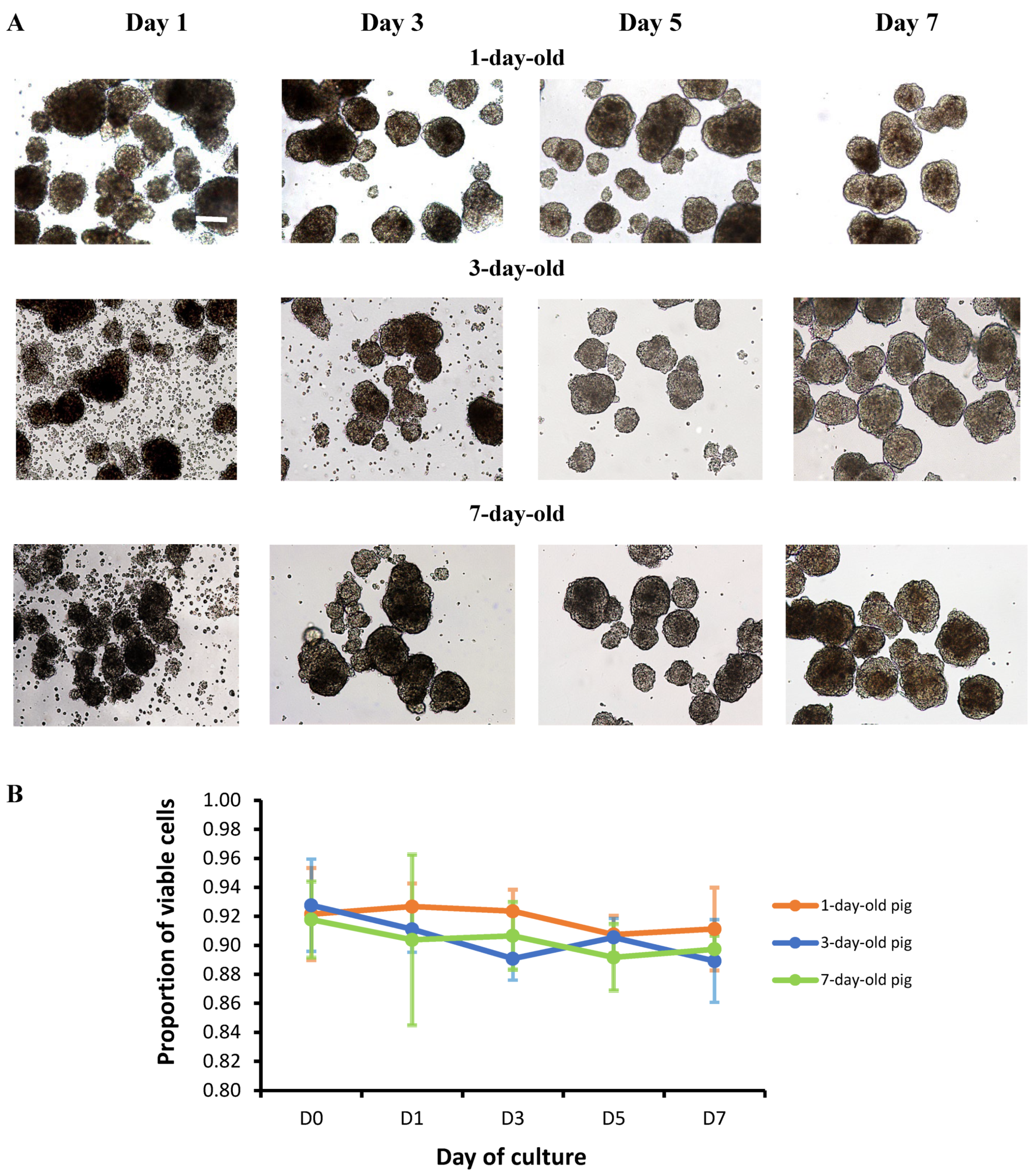
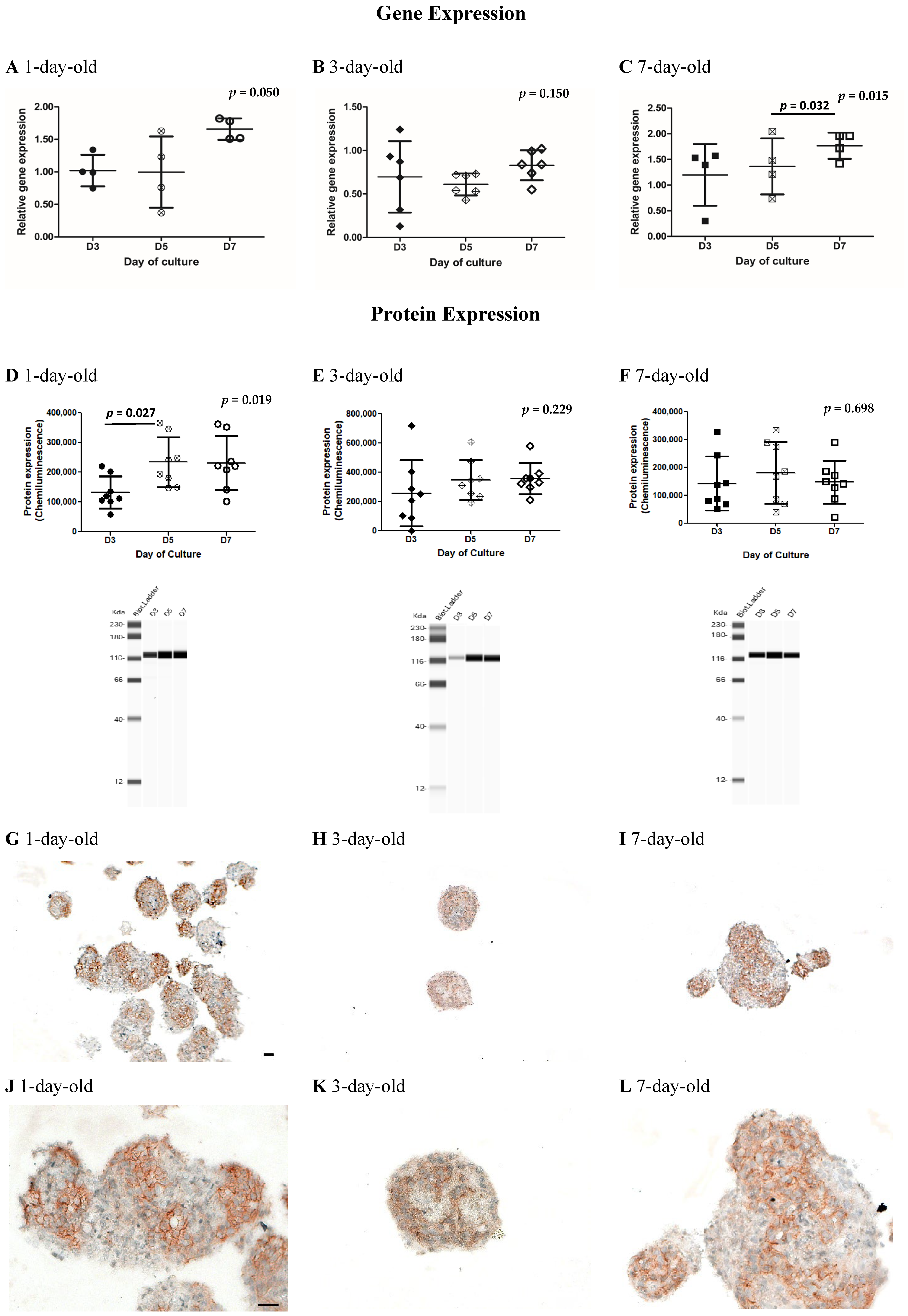
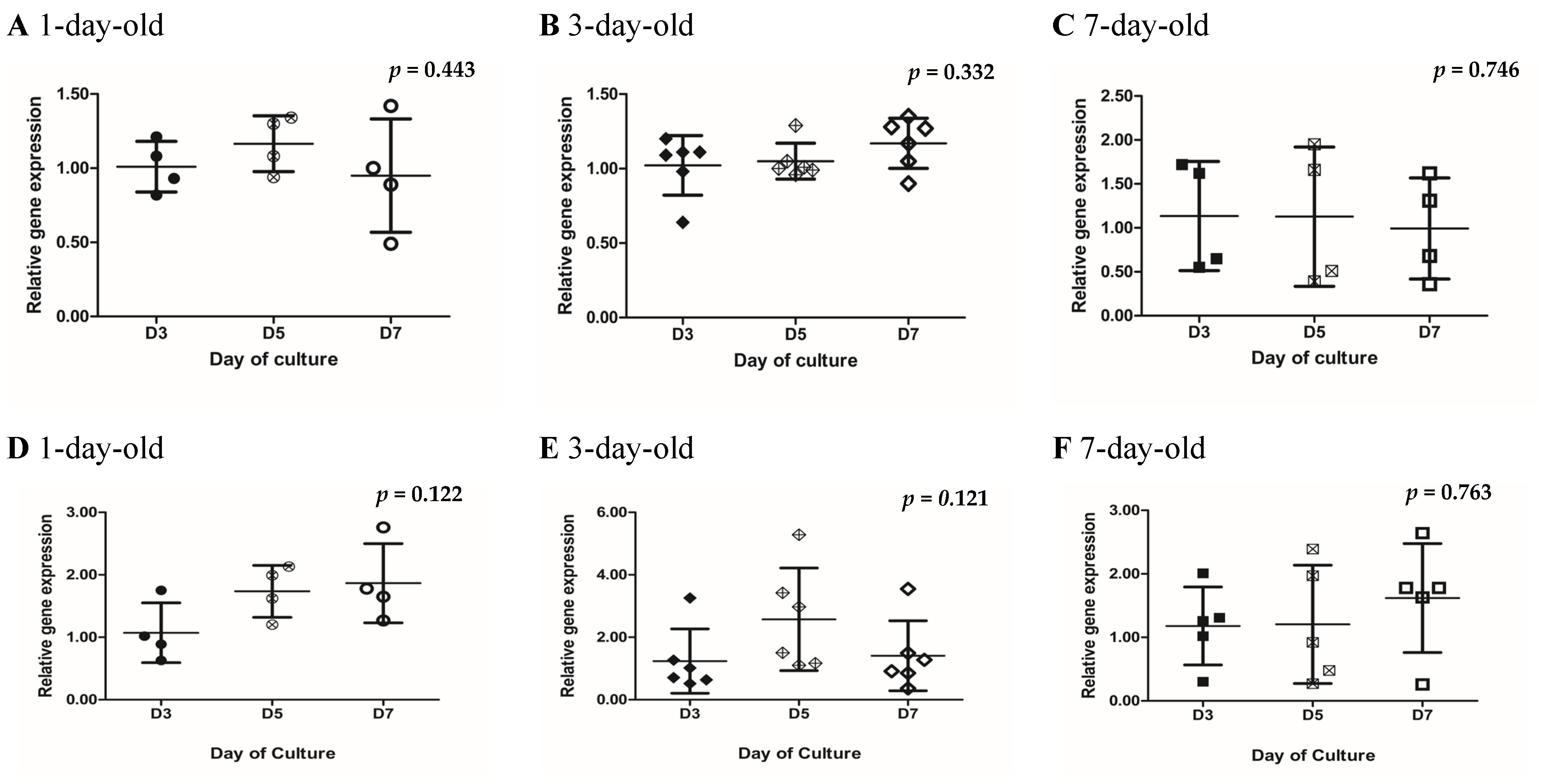
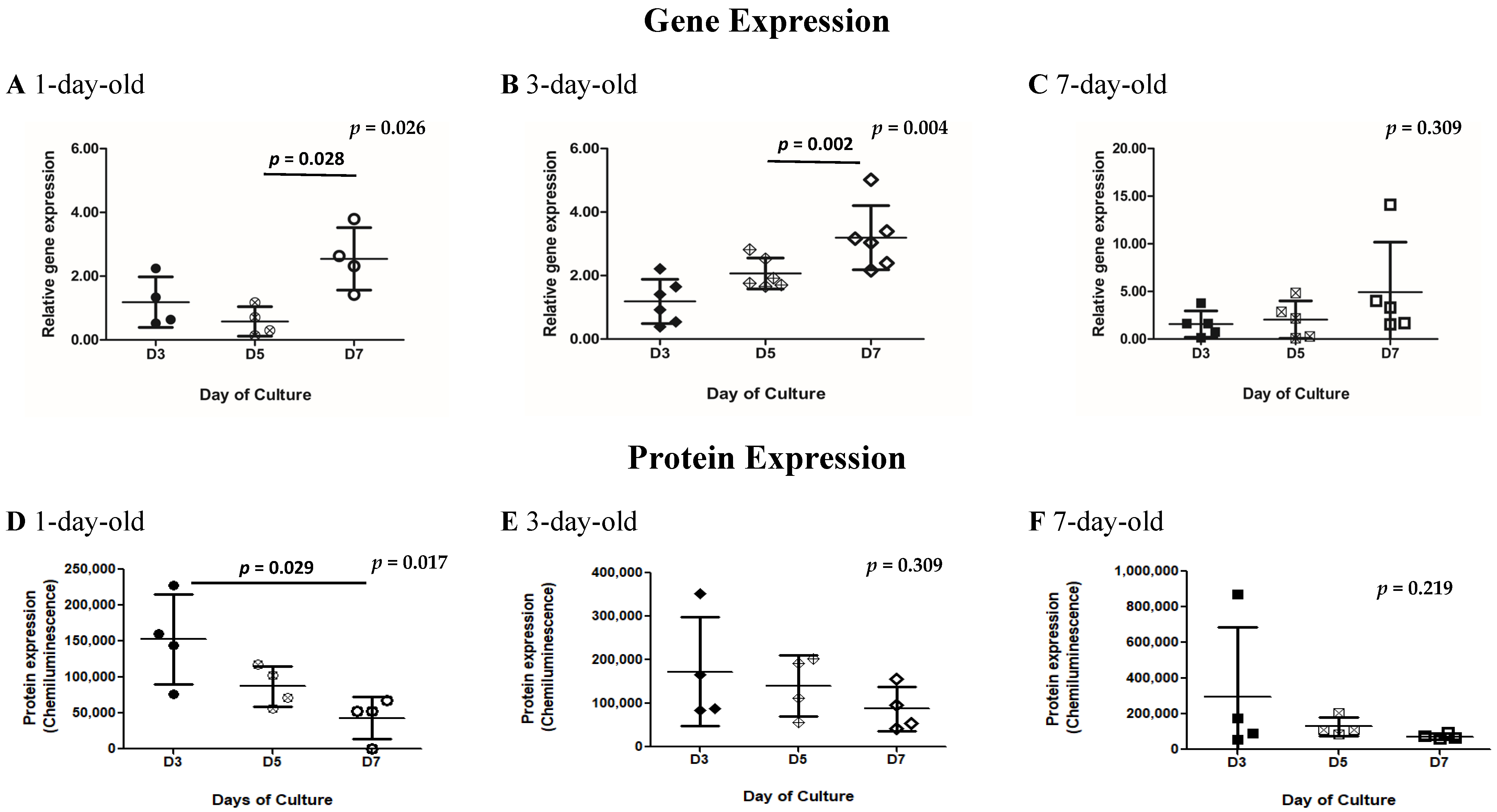
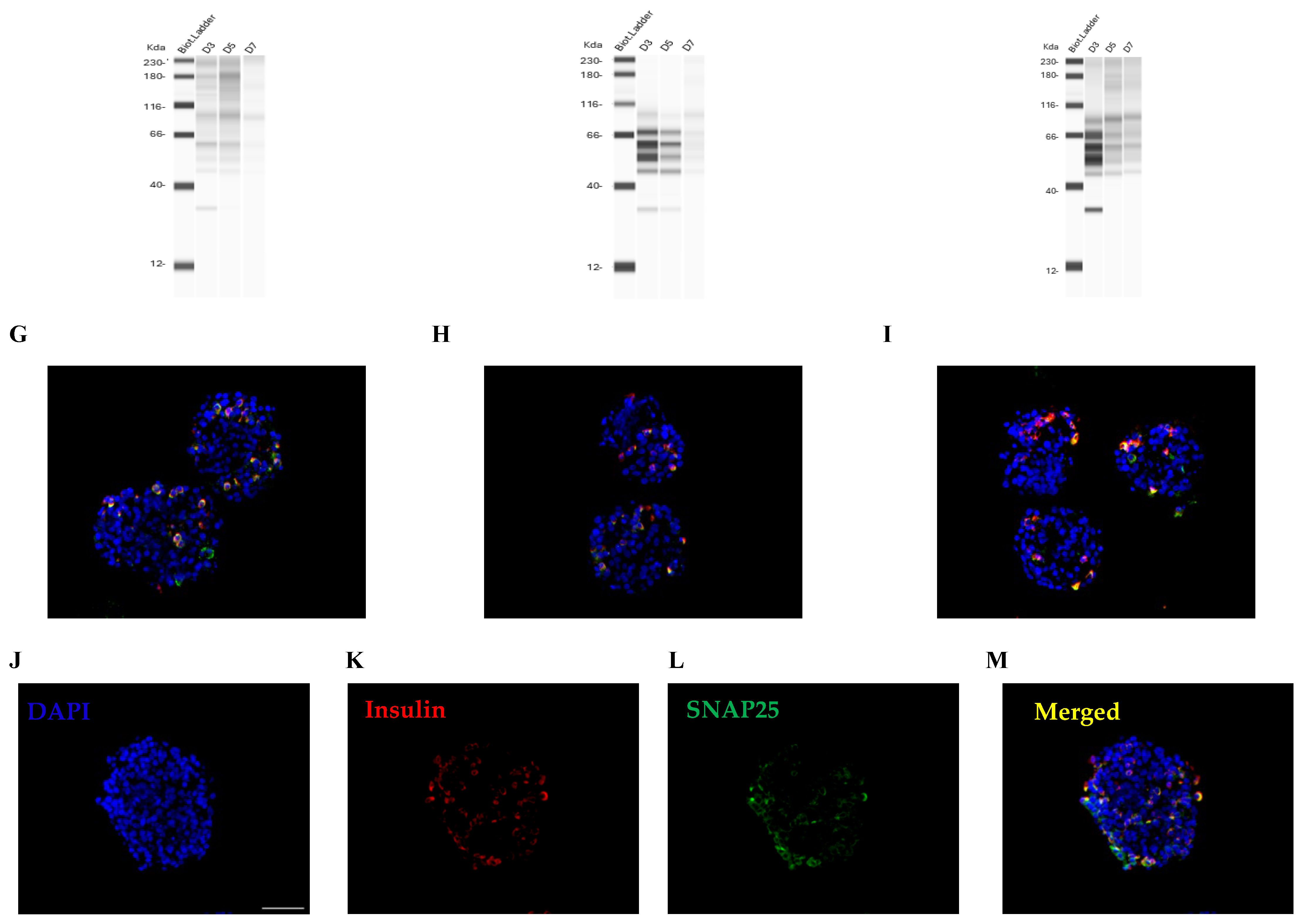
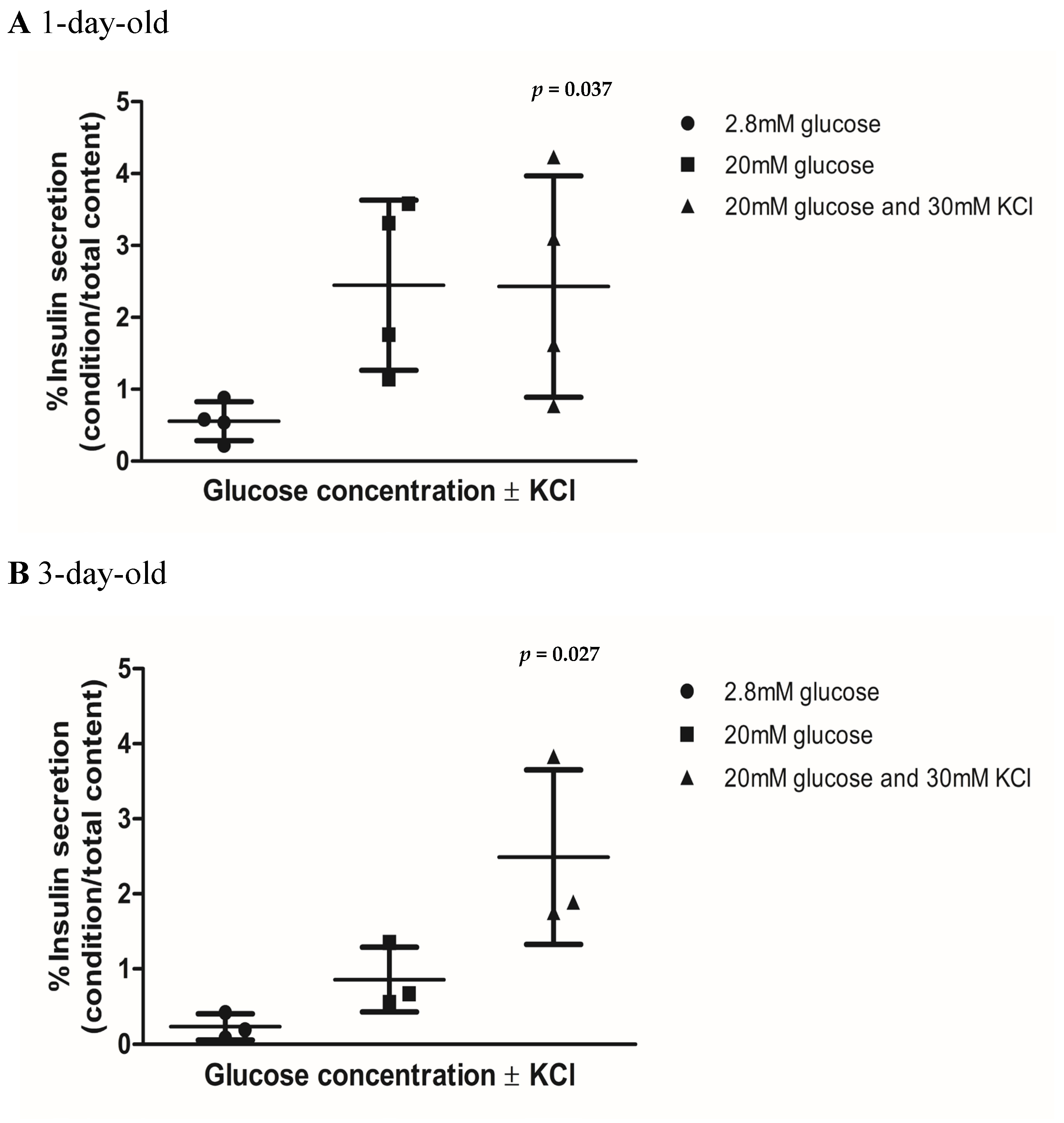
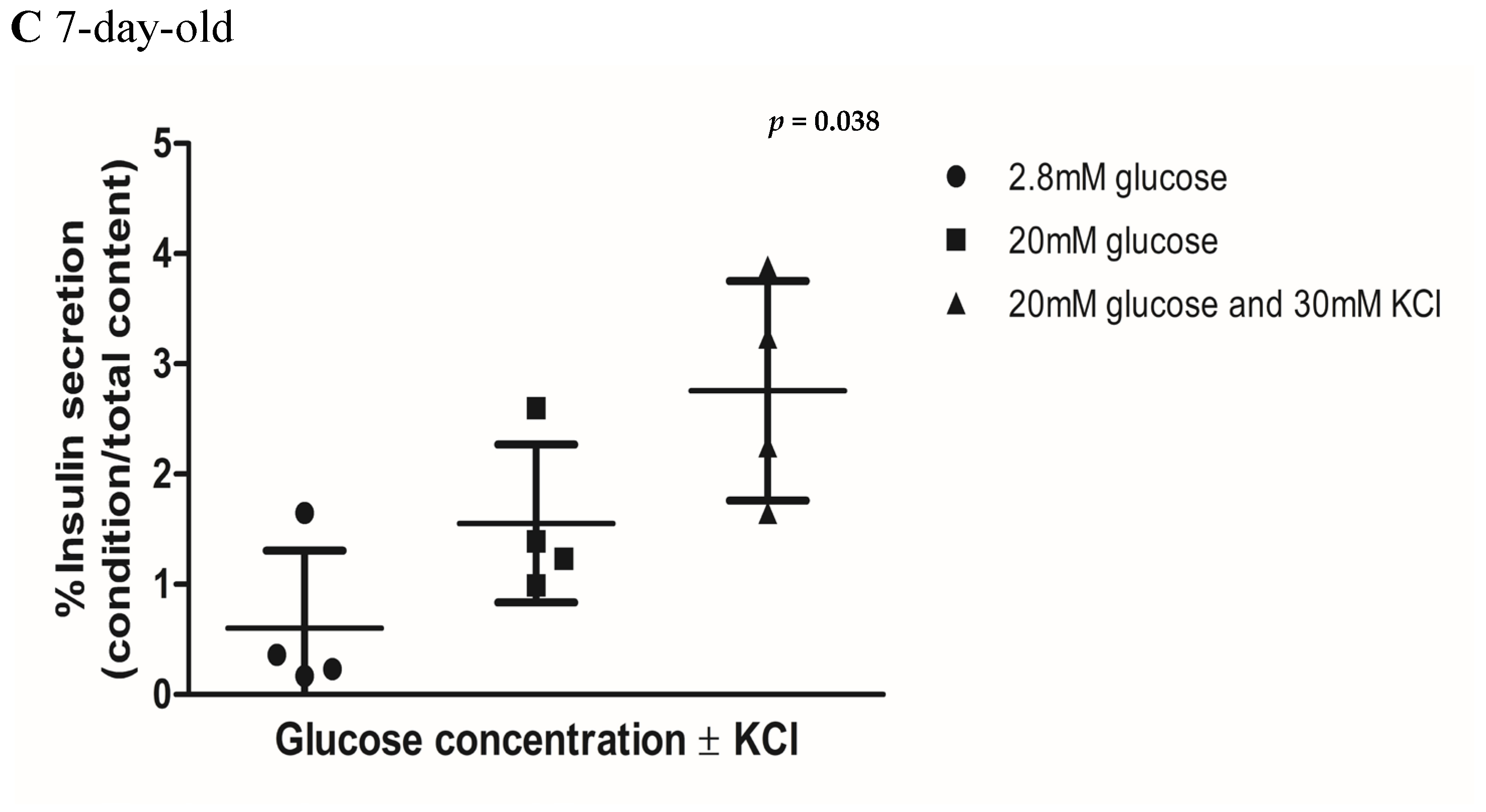
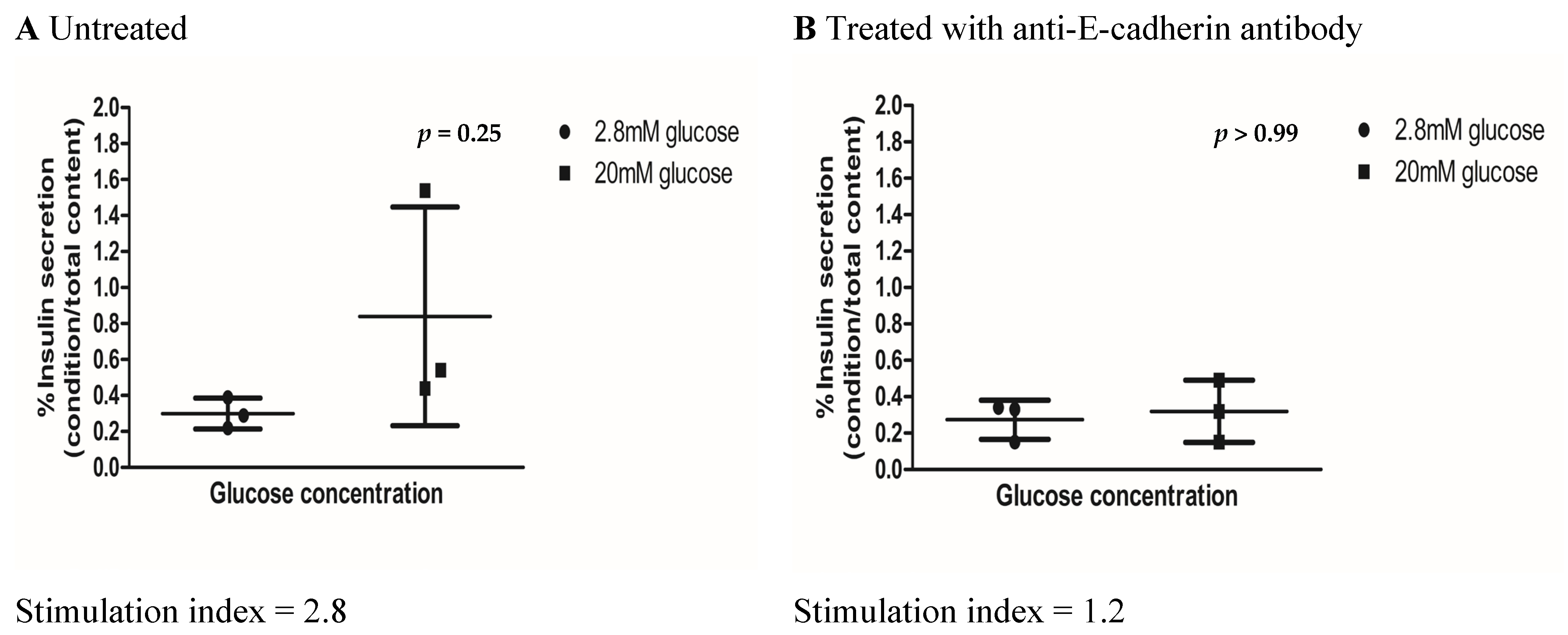
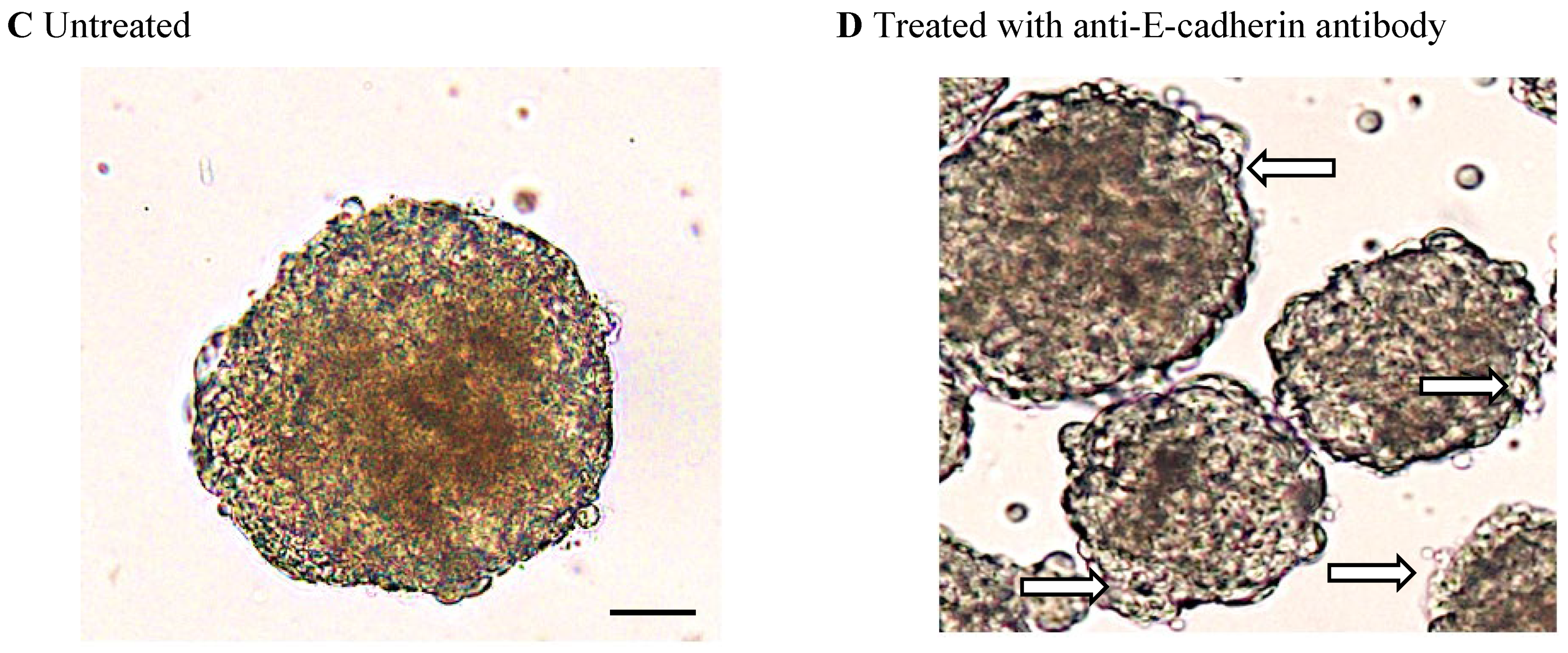
Disclaimer/Publisher’s Note: The statements, opinions and data contained in all publications are solely those of the individual author(s) and contributor(s) and not of MDPI and/or the editor(s). MDPI and/or the editor(s) disclaim responsibility for any injury to people or property resulting from any ideas, methods, instructions or products referred to in the content. |
© 2025 by the authors. Licensee MDPI, Basel, Switzerland. This article is an open access article distributed under the terms and conditions of the Creative Commons Attribution (CC BY) license (https://creativecommons.org/licenses/by/4.0/).
Share and Cite
Purich, K.; Silva, J.R.; Huang, W.; Wickware, J.; Williams, T.; Black, A.; Kim, J.; Chapa, D.F.; Bhavanam, S.; Bigam, D.; et al. E-Cadherin Is Important in the In Vitro Postnatal Development and Function of Pig Islets. Biomedicines 2025, 13, 627. https://doi.org/10.3390/biomedicines13030627
Purich K, Silva JR, Huang W, Wickware J, Williams T, Black A, Kim J, Chapa DF, Bhavanam S, Bigam D, et al. E-Cadherin Is Important in the In Vitro Postnatal Development and Function of Pig Islets. Biomedicines. 2025; 13(3):627. https://doi.org/10.3390/biomedicines13030627
Chicago/Turabian StylePurich, Kieran, Josue Rodriguez Silva, Wenlong Huang, James Wickware, Thomas Williams, Adnan Black, Jeongbeen Kim, David Fernandez Chapa, Sudha Bhavanam, David Bigam, and et al. 2025. "E-Cadherin Is Important in the In Vitro Postnatal Development and Function of Pig Islets" Biomedicines 13, no. 3: 627. https://doi.org/10.3390/biomedicines13030627
APA StylePurich, K., Silva, J. R., Huang, W., Wickware, J., Williams, T., Black, A., Kim, J., Chapa, D. F., Bhavanam, S., Bigam, D., Schiller, D., & Rayat, G. R. (2025). E-Cadherin Is Important in the In Vitro Postnatal Development and Function of Pig Islets. Biomedicines, 13(3), 627. https://doi.org/10.3390/biomedicines13030627






